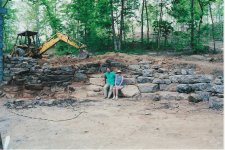That barn took four years to design and build, but telling that story requires beer/w3tcompact/icons/smile.gif You're looking at the south side of the barn. It's 9 1/2 feet from the basement floor to the aisleway floor above. The finish grade will slope more away from the barn than toward the retaining wall so the finished wall height is a maximum of 8 1/2 feet.
The retaining wall in the picture has stood for two winters now without moving. I figure that I'm probably done with that one. The wall on the other end of the barn is now under construction (again). It's full height by about 7 feet. I've got another 16 feet to go.
I had just cut most of the swale on the north side of the barn the day before the deluge, so the damage to the drive was less than it could have been. The water went over the wall on the far side of the barn, instead/w3tcompact/icons/mad.gif There's an erosion channel about 8 inches wide and 6 inches deep running down the drive. Thank goodness my box scraper has finally arrived/w3tcompact/icons/smile.gif
The rocks you can see in the photo are from a highway construction site. They were freshly blasted when I (ahem) "acquired" them/w3tcompact/icons/wink.gif The excavation for the barn turned up three boulders too big for me to move (I didn't have a tractor then). The excavator placed them as the foundation for that wall when he came back for the rough grading. There were also a half dozen or so that I was able to place, then I had to get the rest from off-site.
It turned out that the entire barn site was an area filled with very high quality gravel, probably around 1918, when the house was built. The gravel that came out of the foundation hole was far better quality than the gravel I purchased to make that drive. The drive continues down to the pasture which is about five feet lower than the basement floor. There is a damned lot of fill in it and it's still pretty steep.
The boulders I'm using on the other side of the barn are _much_ bigger. The largest is a rough sphere, 3+ feet in diameter. I was able to pick that one up with the backhoe, but I had to put 600 lbs of rocks in the loader to put the front wheels back on the ground/w3tcompact/icons/shocked.gif
I found most of the boulders when cutting the swale. I used the backhoe to do the rough cutting. I pulled four loader buckets full of boulders and rocks without moving the backhoe in a place about 20 feet from the barn foundation.
I've also found a 66 inch section of finished granite curbstone and a granite quarry billet 81 inches long and seventeen inches wide, the depth varies from six to twelve inches. I found the latter one when digging out a 30 year old pine stump. I'll be using these in front of each of the two aisleway doors as steps.
When I'm done, I'll have a 12-24 inch deep swale from the Southeast corner of the barn to the the Northwest corner. The bottom of the swale is 30-32 feet away from the foundation. The East side will be covered with loam and seeded to lawn. The North side will be covered with five inches of stone dust and be a paddock for the horses.
The swale will carry all of the water from the barn roof, paddock and lawn (including the existing 7000 sq feet of lawn) to drainage pipes on the wooded slope from the barn level down to the pasture and woods on the lower level. After I've refilled the drive and given it a crown, the erosion problems should be minimized.
Matthew (who can be pretty long winded when he gets going)


